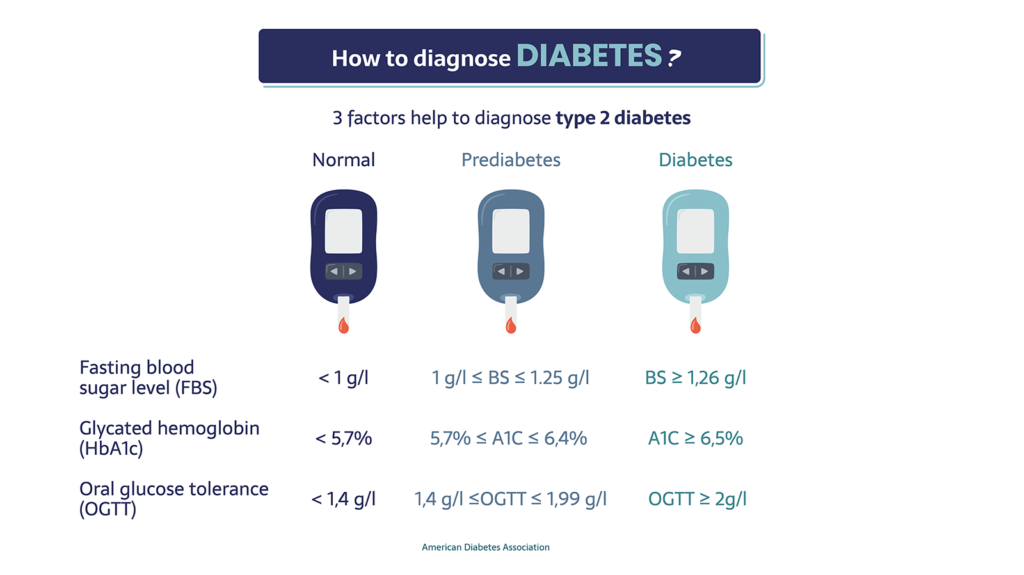
How is diabetes diagnosed?
« 21% of diabetics are over 65 in 2020 »
– www.idf.org : Diabetes facts & figures
Measuring the fasting blood sugar level
Screening for type 2 diabetes is almost always done with a blood test. To be fully effective, this must be done on an empty stomach. In other words, the patient must observe a fast of at least eight hours before the blood test.
Why must the test be done on an empty stomach? It’s so the patient’s body draws on glycogens – glucose stores – to meet its energy needs. A healthy person should not have high blood sugar. In contrast, someone who is diabetic lacks insulin and cannot assimilate glucose. As a result, their blood sugar remains high.
If the tests show a blood sugar level greater than or equal to 1.26 g per litre of blood, then the diagnosis is made. Nevertheless, a second measurement of the fasting blood sugar level should be taken to confirm the diagnosis. In this case, the physician will request further examinations. This includes check-ups on the heart and blood vessels, a neurological check, measurement of weight and height etc.
A blood sugar level of between 1 g and 1.25 g per litre of blood indicates a state of prediabetes.
Nevertheless, screening for type 2 diabetes can be done on a person who does not have an empty stomach. A patient is then judged to be diabetic if their blood sugar level reaches a level equal to or greater than 2 g per litre of blood.
Percentage of glycated haemoglobin
Also called HbA1C, glycated haemoglobin measures the impact of sugar in the blood over the past two to three months. The test is useful for assessing behaviour and the risks of long-term diabetes complications.
Glucose, which generates energy throughout the body, is spread through the bloodstream. Simply put, it binds to haemoglobin and accumulates in red blood cells. In a person without diabetes, glucose remains in the blood to a limited extent. However, a patient with diabetes fixes a large amount of sugar on their haemoglobin.
Red blood cellsare renewed roughly every 120 days. By measuring glycated haemoglobin, the doctor obtains a percentage of the red blood cells ‘fixed’ by glucose. They can then observe the mechanism over the entire lifespan of the red blood cells.
A diabetic patient has a glycated haemoglobin level equal to or greater than 6.5%.
A prediabetic patient has a glycated haemoglobin level of between 5.7% and 6.4%.
Below 5.7%, a person is not diabetic.
This examination is performed at the first diagnosis and then every three months once treatment has started. It helps to follow the course of the disease.
Glucose tolerance test
The last major marker of diabetes is called the oral glucose tolerance test (OGTT). This test is used to diagnose both type 2 diabetes and gestational diabetes in pregnant women.
During the examination, the fasting patient first absorbs one gramme of glucose per kilogramme of body weight, up to a total of 75 grammes. Then, several analyses are carried out at regular intervals for three hours.
In a type 2 diabetic patient, glucose intolerance is measured from 1.4 g per litre of blood. We talk about prediabetes up to 1.99 g per litre of blood. Beyond this limit, the patient is diabetic.

Continue reading :
- What is diabetes?
- Diabetes summarised in three diagrams
- Who is affected and what are the health risks?
- What are the symptoms of type 2 diabetes?
- What is the difference between diabetes and prediabetes?
- Type 2 diabetes: the role of food
- The role of physical activity in combatting diabetes
- Managing stress to avoid type 2 diabetes
Our latest publications
Want to learn more about topics related to blood sugar management?
Here are our most recent blog posts!


Contact information
51 Avenue F. Lobbedez
CS 60946
62033 Arras Cedex
France
Tel : +33 (0)3 21 23 80 00
Fax : +33 (0)3 21 23 80 01





